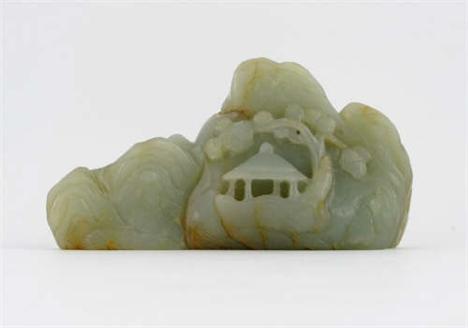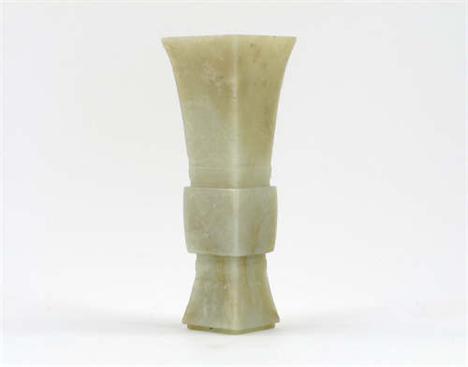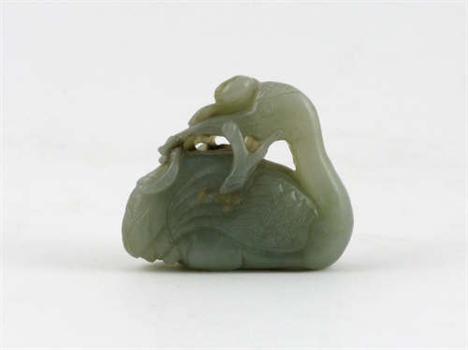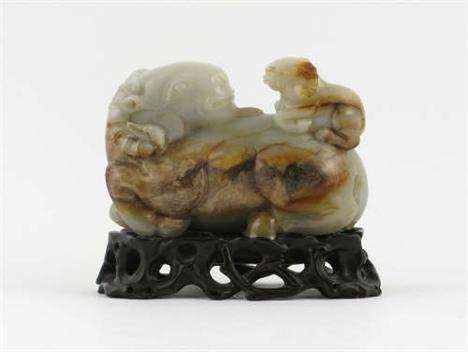We found 64936 price guide item(s) matching your search
Receive email alerts when new lots matching "A Jade" come up for sale.
Receive email alerts when new lots matching "A Jade" come up for sale.
There are 64936 lots that match your search criteria. Subscribe now to get instant access to the full price guide service.
Click here to subscribe- List
- Grid
-
64936 item(s)/page
A Chinese jade peach-shaped libation cup, carved with a reticulated handle formed from leaves, flowers and fruit, a jade two-handled cup carved in shallow relief with a watery landscape and Chinese characters, together with five carved plaques, 19th and 20th centuries, some damages, 11.8cm max. (7)
The Buchanan-Jardine Bitong. A Magnificent Chinese Imperial Spinach-Green Jade Brush Pot (Bitong), Qing Dynasty, Qianlong Period 1736-95, 14.8cm high, 14.1cm dia. With thick cylindrical sides finely and deeply carved with scenes of Daoist immortals in a continuous dramatic tree-lined mountain landscape, the ten small figures arranged in four groups, one of a sage with two attendants carrying fruiting branches and a lingzhi sceptre, beneath rocks besides steps leading up the mountain, another of two figures beneath steps leading to a pagoda retreat, the third of a sage holding a staff and a small boy carrying a peach spray, the fourth of two figures on a mountain bridge, looking out over the landscape, the stone of a deep green color with some paler striations and dark speckling throughout, raised on an elaborate hardwood stand reticulated and carved with peaches, bamboo and chrysanthemum amidst rocks. Exhibited: The International Exhibition of Chinese Art, The Royal Academy of Arts, London 1935/6 catalogue number 2855. Provenance: Sir John William Buchanan-Jardine Bt. Purchased from Spink & Son in 1952. Sir John William Buchanan-Jardine (1900-1969), a Baronet, had a distinguished military career and later became the head of Jardine-Matheson. During his time as head of one of the most powerful organisations of the British Empire in the early 20th century, he had access to exceptional Chinese art works through a period of turmoil when many pieces from the Imperial Collection were dispersed. At some time following the 1935 exhibition, the Buchanan-Jardine collection was in turn sold in London. Catalogue Note: Another jade brush pot in the National Palace Museum, dating from the Qianlong period has similar dense carving and is illustrated in The Refined Taste of the Emperor: Special Exhibition of Archaic and Pictorial Jades of the Ch'ing Court, Taipei, 1997, pp. 172-3, no. 55. See, also, Christie's London 13 May 2008, lot 54 for a larger green jade brush pot dated to the Qianlong period decorated with a rare scene of foreigners and a caparisoned elephant. In a discussion of the large green jade brush pot dated to the 18th century in the collection of Sir Joseph Hotung, Chinese Jade: From the Neolithic to the Qing, British Museum, London, 1995, p.407, no. 29.18, the author, Jessica Rawson, notes that jade workshops sometimes used conventional painting and printing themes as the basis for their designs. The carver treated the surface of the jade almost like a sheet of paper and used his 'techniques to produce the effects of a painting'.
The Bruce Imperial Bi Disc. A Magnificent and Rare Chinese Imperial Spinach-Green Jade Bi Disc, carved with Nine Dragons, Qing Dynasty, Qianlong Period 1736-95, 20.1cm dia. Deeply carved in high relief with nine sinuous writhing dragons and chilongs encircling the central aperture, the reverse carved with an overall array of small raised circular bosses, the stone of a rich even spinach-green colour. Exhibited: The International Exhibition of Chinese Art, The Royal Academy of Arts, London 1935/6 catalogue number 2784. Provenance: The R.C. Bruce Collection. Purchased from Spink & Son in 1952. Catalogue note: Bi discs or stone rings were being made by the people of eastern China as early as the fifth millennium BC. Jade discs have been found carefully laid on the bodies of the dead in tombs of the Hongshan culture (about 3800-2700 BC), a practice which was continued by later Neolithic cultures, After the Shang period they are usually more ornate, carved with dragons, snakes or fish, and used in ritual ceremonies. While the meanings that the Neolithic jades carried in their own time is not known, it is theorized that they were to assist the spirit in the afterlife. A fine white jade bi disc from the Palace Museum Beijing, Gu103121 with related decoration to the reverse of the present example, dated to the Qianlong Period, is illustrated: China, The Three Emperors 1662-1795, No.200. This rare bi disc was reputedly made to celebrate the Qianlong Emperor's 60th birthday.
The Pelham Water Buffalo. An Exceptional Chinese Imperial Spinach-Green Jade Water Buffalo with a Fine Gilt Bronze Stand. Qing Dynasty, Qianlong Period 1736-95, 20.8cm long. Description: The recumbent beast with a serene mildly inquisitive expression, carved from a massive spinach-green boulder; is depicted with his head turned and raised to the right, his facial features with flaring nostrils and alert eyes, framed by horns curling back to his spine, the trumpet-shaped ears and horns finely incised with lines depicting the fur, his dewlap beneath the neck naturalistically carved flowing down to the base, the form of the body accentuated by the superbly defined spine extending to the tail that curls above his hind leg, all four hooves boldly carved on the underside. The gilt bronze base incised with flowers and foliage to the surface above a key fret band bearing a four character Qianlong mark. A narrow band of scrolling flowers and foliage dividing elaborated stylized lappets and with a second key fret band at the foot. Paper label for John Sparks Ltd. 128 Mount Street London. And another inscribed 'The property of Sackville, 5th. Earl of Yarborough'. Provenance: Purchased from John Sparks Ltd. 24th June 1938 for £300. Listed in the Sparks archive as "No. 2988 - 1 v.fine green jade Buffalo, gilt stand, Ming". The property of the late Sackville George Pelham, the 5th Earl of Yarborough, d.1948, and thence by descent. Sackville George Pelham, 5th Earl of Yarborough, MC (17 December 1888 -7 February 1948) was a British peer and soldier, known as Lord Worsley from 1914-1926 and Lord Conyers from 1926 until his accession to the earldom in 1936. Pelham was the second son of Charles Pelham, 4th Earl of Yarborough and his wife, Marcia. In 1910, he became a Second Lieutenant in the 11th Hussars and initially fought as a lieutenant in France during World War I before being promoted to the rank of captain in 1916. During the war his elder brother, Charles, was killed in action and Sackville assumed the former's courtesy title of Lord Worsley. After the war, he was awarded the Military Cross and retired from the Army in 1919 when he married Nancy Brocklehurst (a niece of Lord Ranksborough). On the death of his father in 1936, Sackville inherited the earldom; in the same year he commanded the Nottinghamshire Yeomanry as a Lieutenant Colonel, being posted to Palestine at the outbreak of World War II. On returning to Britain in October 1940, the ship carrying the Earl and Countess of Yarborough came under enemy fire and was sunk. Although most of the passengers and crew survived, the Earl contracted respiratory problems from the smoke, which contributed to his early death in 1948 at the age of 59. His jade buffalo then became the property of his eldest daughter, Lady Diana Miller, who in the same year emigrated to Southern Africa. Whilst the existence of this piece of jade was not in doubt, its whereabouts were subject to some speculation. Many of the Earl's possessions would appear to have been packed and placed in storage at the outbreak of the Second World War and over the subsequent years some inventory records were mislaid. In 2005 Lady Diana Miller returned to the United Kingdom. A large wooden chest, thought to contain porcelain, was opened in July of that year. Inside, amongst the various items, was found an old wooden box, sealed with rusty nails, string and sealing wax. The box was opened for the first time in 65 years, and inside, carefully wrapped in newspapers dated 1940, were the magnificent jade buffalo and its gilt bronze pedestal. Catalogue Note: A small number of large jade carvings, mainly of water buffaloes and horses, were included in the Oriental Ceramic Society exhibition Chinese Jade Throughout the Ages, Victoria and Albert Museum, London 1975, cat. Nos.391-7. They are discussed in the accompanying Transactions of the Oriental Ceramics Society, vol.40, 1973-75, p.118, as being: 'among the most ambitious and monumental examples of jade ever worked in China and perhaps all of them once had their place in the pavilions of the various palaces of Peking.' Another animal from this series, looted from the Summer Palace Beijing in 1860, and reputedly rescued on the troop ship from a soldier who was trying to destroy it, now in the collection of Sir Joseph Hotung, was included in the exhibition Chinese Jade from the Neolithic to the Qing, The British Museum, London 1995, cat.no..26:19. The Jacob Goldschmidt buffalo was exhibited at the influential Ausstellung Chinesischer Kunst, Gesellschaft für Ostasiatische Kunst and Preußische Akademie der Künste, Berlin, 1929, cat.no.1085. The Oscar Raphael buffalo, now in the Fitzwilliam Museum, Cambridge, formed part of the Oriental Ceramic Society exhibition Chinese Jade Throughout the Ages, Victoria and Albert Museum, London, 1975, together with two other jade buffaloes, cat.nos.395-7. Compare the superb gilt bronze stand with those of a pair of spinach-green jade lion dog censers from the Palace Museum, Beijing, GU103379 and GU103380, illustrated: China The Three Emperors, 1662-1795, no.21. The Water Buffalo. The water buffalo is the traditional symbol of spring, strength and tranquillity. Its bucolic aspect evokes the simple and true life in the countryside, and as the reputed mount of the philosopher Laozi, the buffalo has strong Daoist connotations. An important animal in all rice cultivation societies, we find buffaloes depicted in art dating back thousands of years. The Chinese practice of lining the shores of lakes and rivers with bronze buffaloes dates from the Tang dynasty. It is based on the belief that Da Yu, the legendary emperor who is credited with founding the Xia dynasty, (circa 2100 - 1600 BC) and controlled China's floodwaters, used to place iron buffaloes beside each of his projects. The most famous is the bronze example overlooking Lake Kunming in Beijing's Summer Palace, which was cast and then personally dedicated by The Emperor Qianlong in 1755. With thanks to Miss Ching-Yi Huang of SOAS for her help in researching the Sparks' archive. Est: Refer Department
Ornate antique gold plated key ring with ornate watch key & miniature fob seal, set with carnelian, intaglio pattern of hand with bird perched on finger, sprig of foliage in beak, a rectangular gold plated ornate fob set with carnelian & various elephant charms in jade, coral & rose quartz, one jade with trunk missing (6)
A fine Russian nephrite and jasper vase, the everted rim to an ovoid body and an applied band of leaves carved from revna jasper, on a spreading foot, early 19th century, 16.75in (42.2cm) h, 10.5in (26.7cm) dia. Minor nicks to edge, a section of one leaf lacking, a flat chip to the body. Provenance: The Property of Lord and Lady Fairhaven. Russian nephrite, a calcium magnesium silicate form of jade is found in Siberia and mined near Lake Baikal. Revna jasper a rare grey and green veined jasper is found in the Ural mountains not far from the Imperial Lapidary workshops in Kolyvan which was established in 1786 and produced decorative items including urns, fireplaces etc for the Imperial court. Nephrite was favoured by the Russian Imperial family at the end of the 19th century and Carl Faberge was commissioned to produce precious objects made of and adorned with nephrite. An ormolu mounted vase was sold Christie's London, Important European Furniture, 12th December 2002, lot 1 for £34,655 (including premium).
A yellow gold ruby and seed pearl eternity ring, a platinum band ring, approximately 1g, a 14ct gold and jade ring, an 18ct gold and seed pearl ring (some missing), a damaged 9ct gold diamond and ruby eternity ring, a 9ct gold initials ring "H G" five 9ct gold dress rings and two other dress rings (13)
-
64936 item(s)/page

























































